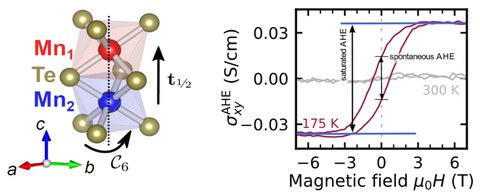Feb 13, 2023
Spontaneous Anomalous Hall Effect Arising from Altermagnetism
The anomalous Hall effect (AHE) has been attributed to a time-reversal symmetry breaking coming from a strictly magnetic environment in ferromagnets and noncollinear magnetic materials. Nonetheless, recent predictions suggested that the AHE could also be expected in collinear,magnetically compensated materials which belong to the newly identified magnetic class known as altermagnets. In our recent paper, we study epitaxial thin films of MnTe, which is an altermagnetic semiconductor. The magnetic Mn atoms are surrounded by an anisotropic crystal environment due to the nonmagnetic Te atoms located at non-centrosymmetric positions. As a consequence, time-reversal symmetry breaking and an alternating spin polarization in the electronic band structure are
expected. We experimentally verified the presence of the anomalous Hall effect despite the negligible net magnetization and collinear spin ordering. Consequently, MnTe represents a promising material in the emerging research of altermagnets.
Gonzalez Betancourt, R. D., Zubáč, J., Gonzalez-Hernandez, R., Geishendorf, K., Šobáň, Z., Springholz, G., Olejník, K., Šmejkal, L., Sinova, J., Jungwirth, T., Goennenwein, S. T. B., Thomas, A., Reichlová, H., Železný, J., & Kriegner, D. Spontaneous anomalous hall effect arising from an unconventional compensated magnetic phase in a semiconductor. Physical Review Letters 130 (2023), 036702

